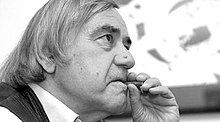This is an old revision of this page, as edited by I dream of horses (talk | contribs) at 02:18, 21 December 2021 (Random page patrol with AutoWikiBrowser, typo(s) fixed: ’s → 's, 1944-45 → 1944–45). The present address (URL) is a permanent link to this revision, which may differ significantly from the current revision.
Revision as of 02:18, 21 December 2021 by I dream of horses (talk | contribs) (Random page patrol with AutoWikiBrowser, typo(s) fixed: ’s → 's, 1944-45 → 1944–45)(diff) ← Previous revision | Latest revision (diff) | Newer revision → (diff)| Dušan Džamonja | |
|---|---|
 | |
| Born | (1928-01-31)31 January 1928 Strumica, Kingdom of Yugoslavia |
| Died | 14 January 2009(2009-01-14) (aged 80) Zagreb, Croatia |
| Nationality | Croatian Serb |
| Education | Zagreb Academy of Fine Arts |
| Known for | Sculpture |
| Movement | Modernism |
Dušan Džamonja (Template:Lang-sr, pronounced [dǔʃan dʒamoɲa]; 31 January 1928 – 14 January 2009) was a Yugoslav, Croatian and Serbian sculptor of Serbian ancestry.

Education and career
In 1945, Džamonja began his studies at the Academy of Fine Arts in Zagreb under the professors Vanja Radauš, Frano Kršinić and Antun Augustinčić, all notable artists. In 1951, he graduated in the master class of professor Antun Augustinčić. He worked in the Krsinic workshop from 1951 until 1953 when he started his own workshop in Zagreb.
In 1954 he held his first solo exhibition in the Salon ULUH in Zagreb. In 1970, he began the construction of his house and workshop in Vrsar, Istria according to his own design.
Artistic style
Džamonja drew primarily in chalk and used the technique of washed ink; however, he leaned towards sculpture early on. He used many materials, from bronze and iron to wood, glass, concrete and polyester in his sculptures.
Works
His works are in numerous public and private collections, museums and galleries in the country and abroad. However, his most notable works are:
- Dušan Džamonja's Park of Sculptures, near Vrsar, is a famous and cultural tourist attraction.
- Monument to the Revolution (1967), World War II memorial in Podgarić, Croatia.
He designed many monumental memorial complexes. These include:
- The Revolution Memorial in Podgarić, Croatia.
- Monument to the Revolution on Mrakovica Mountain, Kozara National Park, Republika Srpska, Bosnia & Herzegovina.
- The Memorial Ossuary to the Fallen Yugoslav Soldiers of the First and Second World Wars in southern Italy, Barletta.
He designed a number of monuments to the Partisans and victims of concentration camps, most notably the Memorial Ossuary at Barletta, near Ban (completed 1970) and the Monument to the Battle of Kozara (completed 1972).
Awards and accomplishments
He was a recipient of numerous awards and was an academician with both Croatian Academy of Sciences and Arts and Serbian Academy of Sciences and Arts. Below is a list of his awards:
- 1958 Third and Fourth Award for conceptual design for Memorial in Jaijinci, Yugoslavia
- 1959 One of six identical awards on international competition for Monument to the Victims of Dachau, Germany First Award for sculpture, Salon 59, Rijeka, Croatia
- 1960 City of Zagreb Award, Croatia
- 1961 Premio Morgan's Paint, Rimini, Italy First Award for sculpture, First Triennale of Modern Sculpture, Beograd, Yugoslavia
- 1962 Fourth Award, National competition for Monument to Revolution in Slavonija, Kamensko, Croatia
- 1963 Second Award, IV Biennale, San Marino, Italy
- 1965 Gold Medal for artistic activity, Veruchio, Italy
- 1968 Second Award on the competition for Monument to Victims of Fascism in Podhum, Rijeka, Croatia First Award for Memorial Ossuary in Barletta, Italy
- 1970 First Award for Monument to Revolution, Kozara, Bosnia
- 1974 Second Award for design of Memorial Ossuary, Roma, Italy First Award for conceptual design for Memorial to Victory and Fallen Fighters, Sremski Front 1944–45, Yugoslavia
- 1977 Rembrandt Prize, Goethe Stiftung zu Basel, Switzerland
- 1980 Second Award for conceptual design for Monument to Edvard Kardelj, Ljubljana, Slovenia
- 1982 Second Award for National Competition for the Monument in Jajinci, Beograd, Yugoslavia
- 1983 Third Award, Terceiro Biennale der Europäischen Grafik, Baden-Baden, Germany 1986 Award of the Jury, Biennale of Original Drawing, Rijeka, Croatia
- 1990 Second Prize for the design of the Monument on Rhein - Main - Donau Kanal, Germany
References
- "Neukrotiva mašta Džamonje". www.novosti.rs (in Serbian (Latin script)). Retrieved 2019-01-09.
- Latinović, Đorđe. "Druga Hrvatska". Nezavisne novine (in Serbian). Retrieved 2019-01-18.
- "Tko je tko i odakle: strani velikani hrvatske kulture – Nacional.hr". arhiva.nacional.hr. Retrieved 2019-01-18.
- "Press nabrojao "hrvatske Srbe": Zar vam Tesla i Arsen Dedić nisu ništa dobro donijeli?". www.index.hr (in Croatian). Retrieved 2019-01-18.
- ^ "Top-lista spomenika NOB-u". Jutarnji list (in Croatian). 16 May 2009. Archived from the original on 7 January 2010. Retrieved 10 June 2010.
- ^ "Dusan Dzamonja (1928)". ArtFact. Retrieved 10 July 2013.
- ^ "DUŠAN DŽAMONJA". PUBLIC INSTITUTION JASENOVAC MEMORIAL AREA. Retrieved 10 July 2013.
- ^ "DŽAMONJA SCULPTURE PARK". VRSAR Inspires. Archived from the original on 6 August 2013. Retrieved 10 July 2013.
- "Dusan Dzamonja 1928–2009". Tate. Retrieved 11 July 2013.
- "Awards". The Art Site of Dušan Džamonja. Retrieved 11 July 2013.
External links
- Brown to dedicate sculpture by Yugoslavia’s Dusan Dzamonja Oct. 12, 1990
- Art Site of Dušan Džamonja
- Interview with Dušan Džamonja / Sculpture as a Spiritual Adventure, Croatia (inflight magazine), spring/2002
- 1928 births
- 2009 deaths
- People from Strumica
- Serbs of Croatia
- Croatian sculptors
- Serbian sculptors
- Male sculptors
- Modern sculptors
- Members of the Croatian Academy of Sciences and Arts
- Members of the Serbian Academy of Sciences and Arts
- Academy of Fine Arts, University of Zagreb alumni
- Vladimir Nazor Award winners
- Macedonian artists